The Best Way to Mince Garlic
Does the method of mincing garlic matter? We tested various methods to find out.
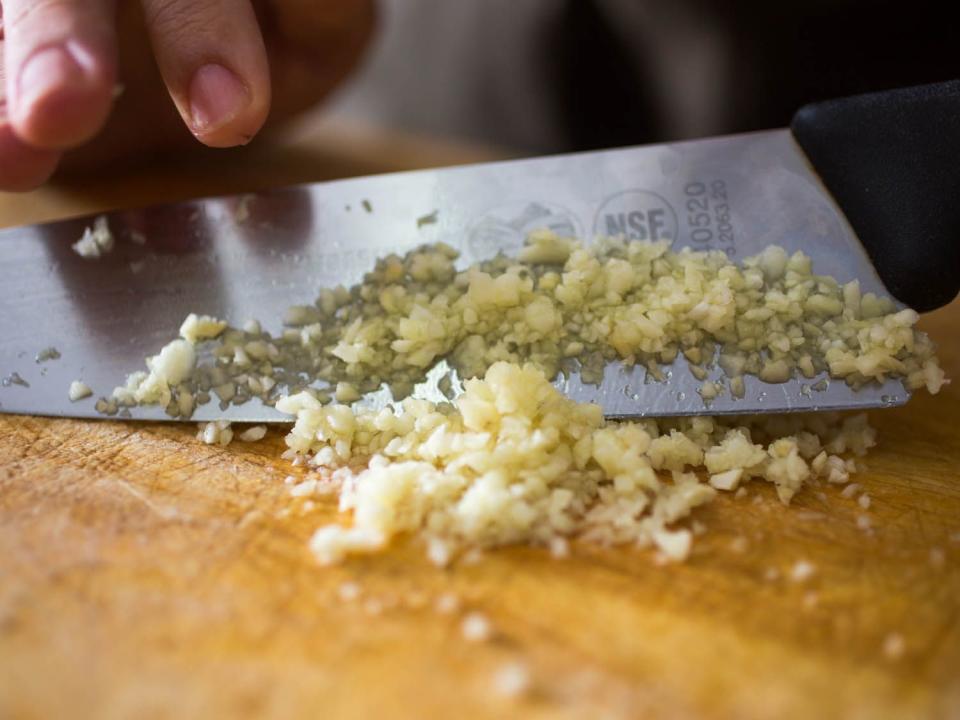
Serious Eats / Daniel Gritzer
I remember the first time I saw a chef use a microplane grater to finely mince a clove of garlic. He was making mayonnaise, and in just a few seconds the clove had dissolved into a fine puree that fell directly into the mixing bowl below. I was blown away, and from that day forward, it was one more trick in my garlic-prep pocket.
Fast forward to a few months ago. I was working on a shrimp scampi recipe, and, for speed, I ran some of my garlic through a microplane. When I dropped it into the pan of hot oil, I felt a searing sensation in my nose, like a strong hit of wasabi, and my eyes began to water. It tasted even worse, with a bitter flavor that ruined the shrimp.
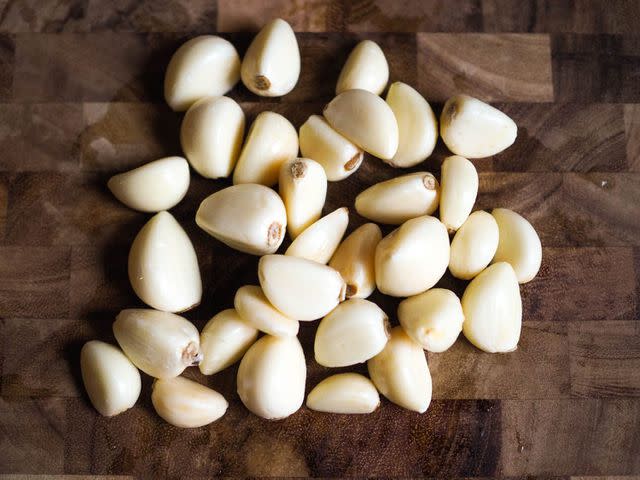
Serious Eats / Daniel Gritzer
""the more cells we rupture when cutting garlic, the more potent it is.""
The fact that microplaned garlic is more pungent than minced isn't particularly shocking in and of itself. We all know that garlic's intensity in a dish isn't just dependent on how much garlic there is, but also how it's been prepared: a single whole clove will deliver less intensity than a crushed one, a crushed clove will be milder than a sliced clove, and a sliced one isn't as pungent as a chopped or pureed one—the more cells we rupture when cutting garlic, the more potent it is.
What shocked me, though, was the degree of difference between finely minced garlic and grated garlic. The microplaned garlic wasn't just more intense than minced, it was downright noxious. You could defeat an army with its mustard gas-like punch.
I've been curious about this effect ever since, so I decided to dig a little deeper with some more focused testing. The results are helpful, because they shed light on just how important the mincing method can be. Deciding whether to finely chop, crush in a mortar and pestle, pass through a garlic press, or reach for that microplane isn't just a question of which you find most convenient: it can have a major effect on how your food tastes.
The Best Defense Is a Good Offense
If you're wondering why garlic smells the way it does, the answer is biological warfare. When its cells are damaged, say, by a pest, two molecules, one called alliin and an enzyme named alliinase come into contact with each other, and together produce a new compound called allicin, which is responsible for the pungent, vampire-repelling smell we associate with garlic. The more cell damage that occurs, the more allicin is produced, and the stinkier the garlic becomes, which is why a single clove can have such varying impact on a dish depending on its form.
According to McGee, there are plenty of other forces at play that also have an effect on the potency of garlic. Everything from the variety of the garlic, to the temperature where it's grown (cold apparently makes for stronger garlic), and what kind of fat it's cooked in (butter leads to milder garlic flavors while unsaturated vegetable oils unleash more assertive ones) can change how it smells and tastes.
Despite garlic's best self-defense efforts, though, we humans can't seem to get enough of it.
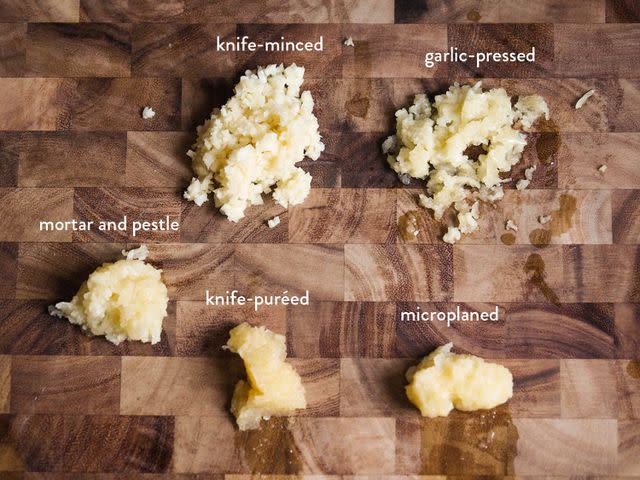
Serious Eats / Daniel Gritzer
To start my garlic tasting, I first wanted to focus on the flavors of raw garlic minced several different ways. They included hand-chopping, garlic press, mortar and pestle, knife-blade pureeing, and microplane. I tasted each method multiple times and in different orders to give each a fair shake.
Unfortunately for my girlfriend Kate, I ate all this raw garlic before heading to an evening salsa class with her. (Sorry, baby!)
Hand-Minced With a Knife
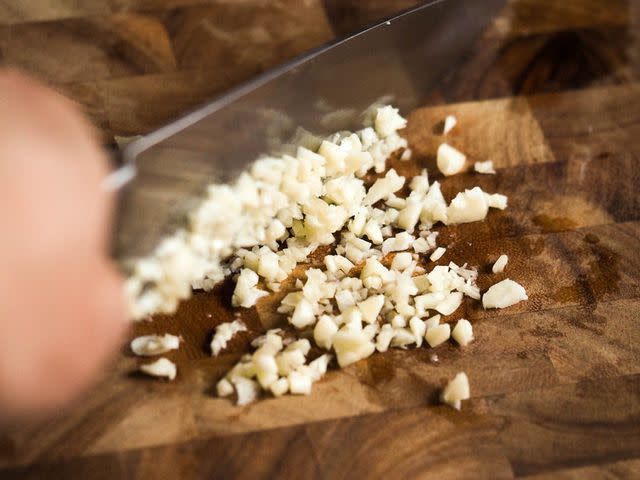
Serious Eats / Daniel Gritzer
This is the technique I use most often in my own cooking, passing the knife repeatedly over the garlic until it's been reduced to a pile of fine bits. While tiny, the knife-minced garlic has the largest and most discrete pieces than any of the other methods I tested. It's also the driest—hand mincing doesn't break open and release the fluids of as many cells as the other methods.
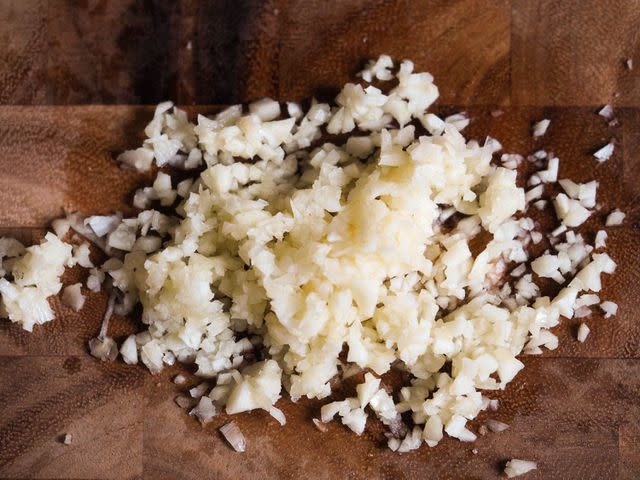
Serious Eats / Daniel Gritzer
Knife-minced garlic.As for taste, the hand-minced garlic was relatively mild (relatively is a key term here). It had a nice garlicky flavor that, even after chewing, remained on the mellow side. A subtle burn eventually kicked in, but it was slow and never really hit unpleasant levels.
Garlic Press
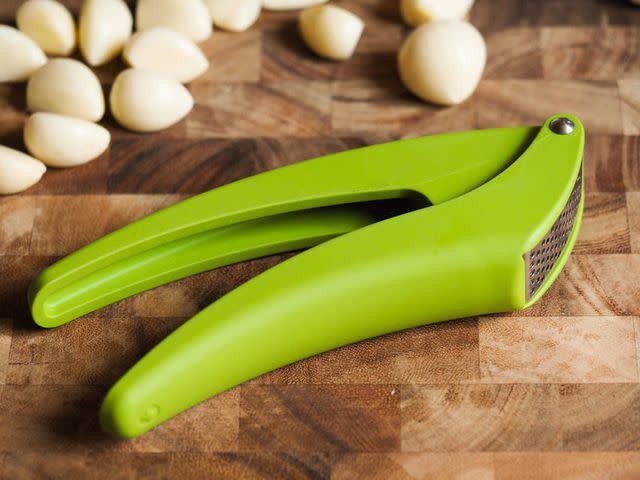
Serious Eats / Daniel Gritzer
The garlic press has gotten a pretty bad rap, and a lot of cooks would be ashamed to be caught with one (others have come to its defense). I haven't owned one in years, but I picked one up for these tests, and it honestly wasn't as bad as I was expecting. It wasn't great either: the garlic came out in a pile of irregular squiggles and juice sprayed as I squeezed the handles.
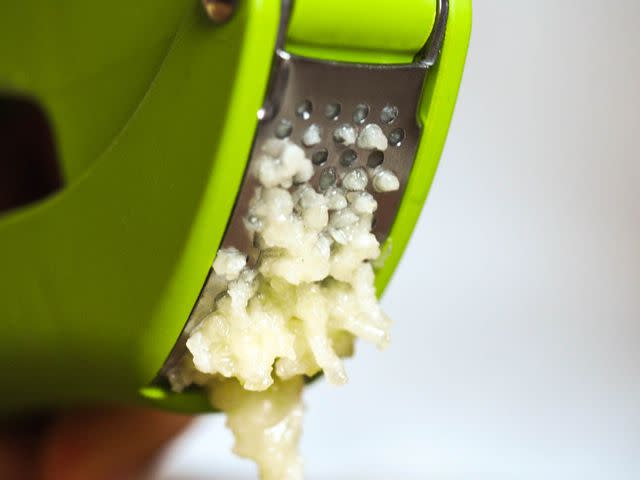
Serious Eats / Daniel Gritzer
The flavor was more aggressive than the hand-minced cloves, and started to burn my tongue after about five seconds. Here's one notable word from my tasting notes: "farty". Still, it wasn't the abomination some folks have claimed it to be.
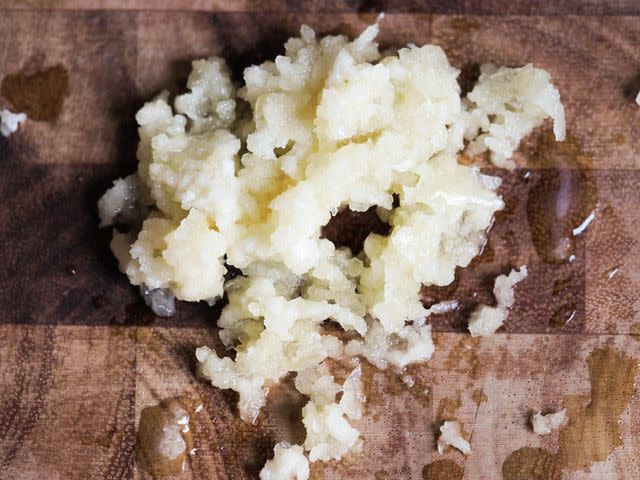
Serious Eats / Daniel Gritzer
Garlic-pressed garlic, with some of the sprayed juices can be seen on the cutting board.Mortar and Pestle
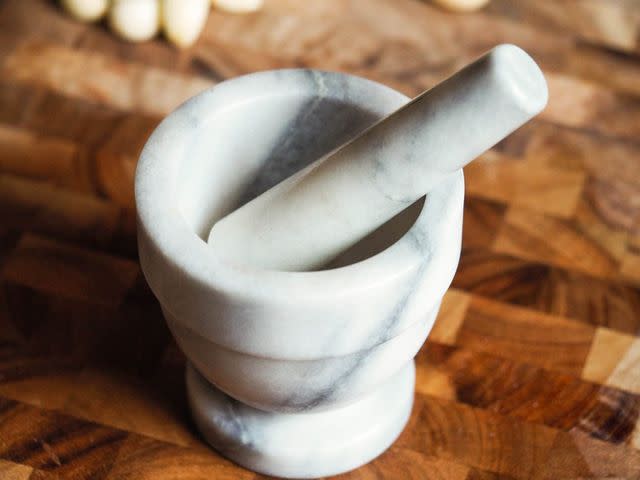
Serious Eats / Daniel Gritzer
I was bracing for a really intense garlic flavor from the mortar and pestle, given how thoroughly you can pulverize garlic in it, but I was surprised to find it not much more aggressive than the garlic press.
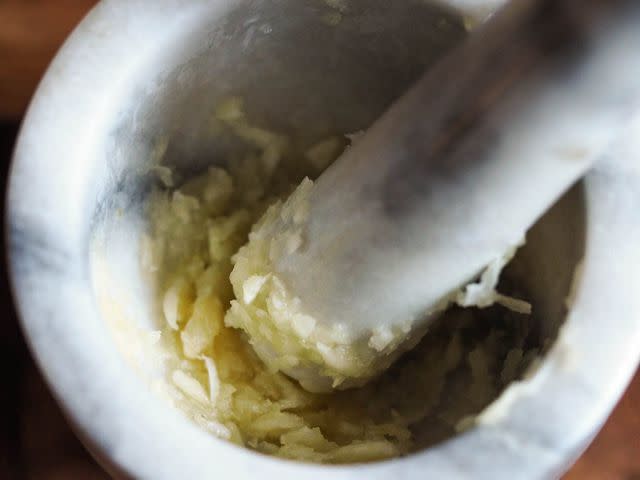
Serious Eats / Daniel Gritzer
It emitted some sulfur notes, but it also had a sweetness to it, with a not-too-strong burn.
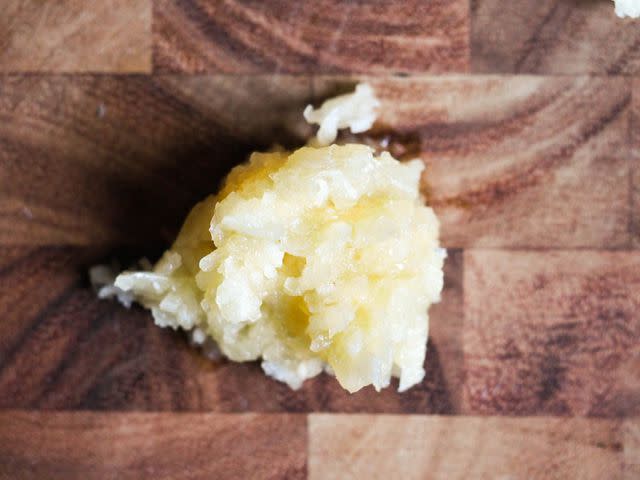
Serious Eats / Daniel Gritzer
Knife-Blade Puréeing
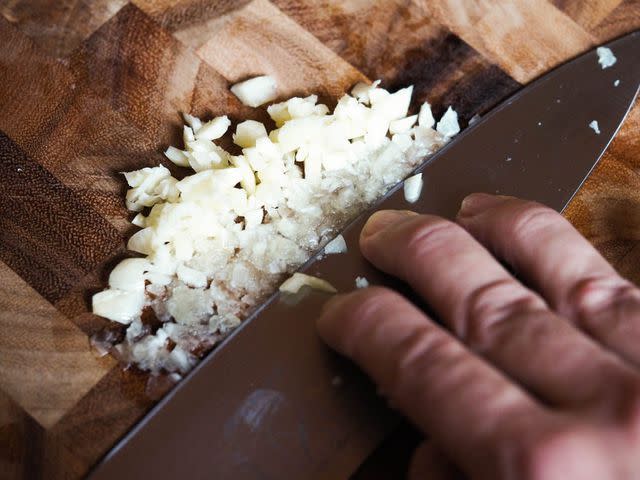
Serious Eats / Daniel Gritzer
This isn't the easiest technique to learn, but with a little practice anyone can master it. To do it, start by roughly mincing the garlic. Then, with the side of the blade's edge, you push down to crush the little bits into a purée. Try to smash too much under the blade at once and it becomes incredibly difficult if not impossible. Normally, I sprinkle salt on top of the garlic, which acts as grit to break the garlic down, but for this test I left to salt out to keep it similar to the other samples.
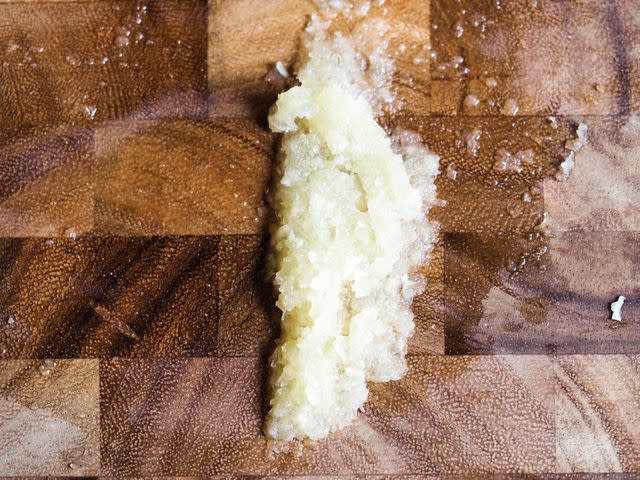
Serious Eats / Daniel Gritzer
Knife-blade pureed garlic.The flavor of this raw puree was tolerable, but it had a burn that kicked in fast and then started to feel painful. This is intense stuff.
Microplane
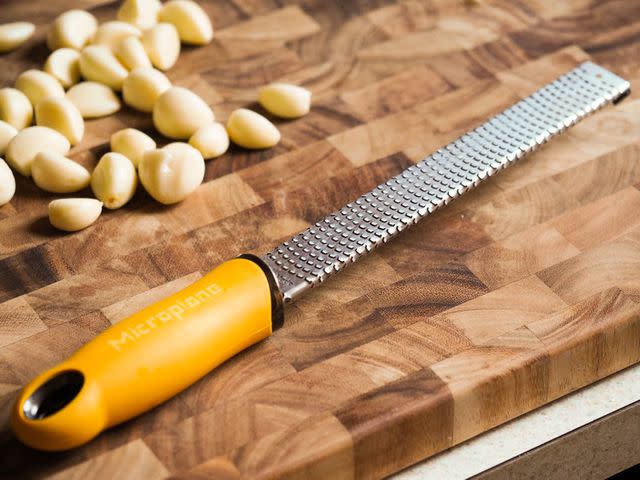
Serious Eats / Daniel Gritzer
I'll quote myself from my tasting notes here: THIS HURTS OH MY GOD SAVE ME MY TONGUE WAAAAAHHHHHH!
Next thing I knew I had my head in the sink, whimpering as cold water splashed over my extended tongue. When I repeated this test later, I was immediately back under the sink.
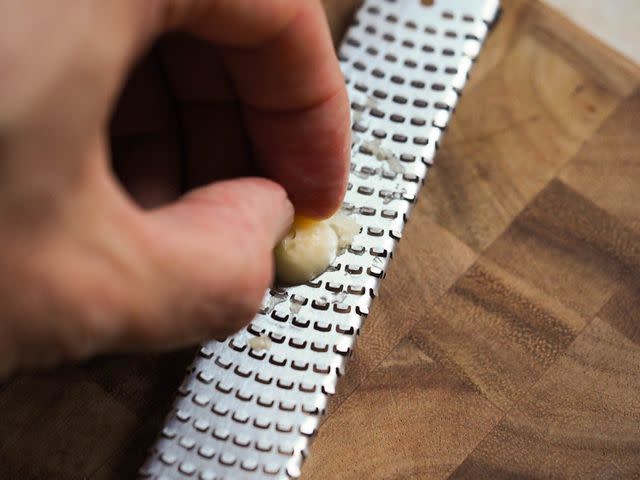
Serious Eats / Daniel Gritzer
Without the aid of a microscope and all sorts of other tools, I can't say with any certainty why the microplane produces raw garlic that is so dramatically different from the others, but it really does seem to. To the naked eye, it certainly looks the most pureed of all the samples.
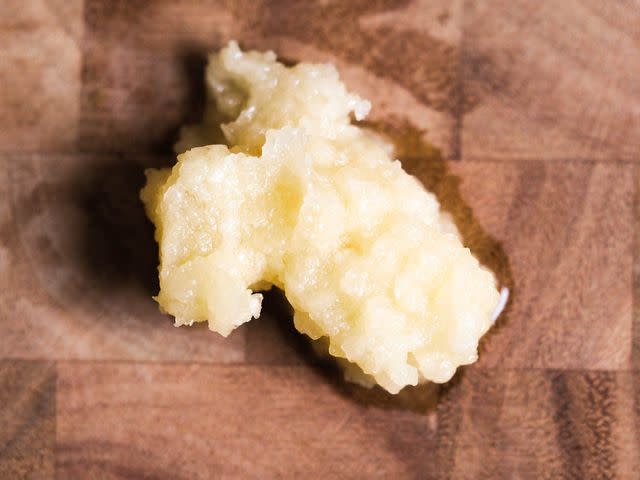
Overall, what I took away from this raw-garlic test is that on the mincing spectrum, knife-minced garlic is by far the mildest, microplaned garlic is so aggressive it could be charged with assault, and the other three are in the middle with very different textures but not remarkably different flavors.
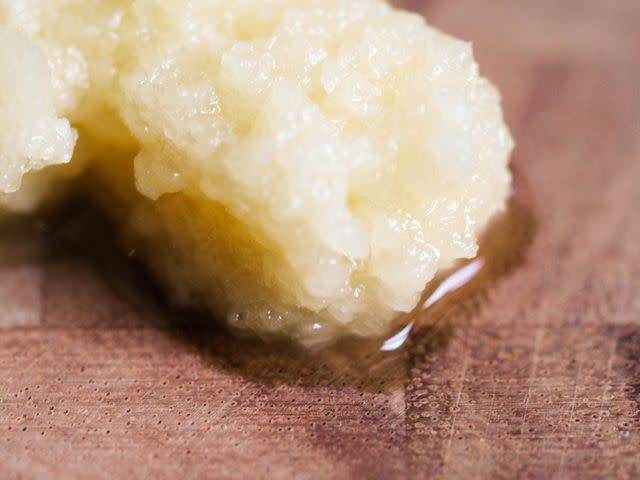
Quick Cooking
Next, I wanted to see how the flavor of each method changed when exposed to high heat for a short amount of time. To test it, I cooked one teaspoon of each type of garlic in one tablespoon of melted butter over high heat.
Here's what I found:
Knife-Minced: Once again mild, with little bits of chewable garlic that are tender and sweet.
Garlic Press: Stronger overall flavor than the knife minced, with a medium burn in the throat. It's a little sweet but also a little harsh.
Mortar and Pestle: Quite sweet with tender mashed chunks. Pretty tasty, with a very mild burn that sets in late in the back of the mouth.
Knife Puréed: The baby bear—neither too sweet nor too harsh, too mild nor too strong.
Microplane: The burn sets in faster than the others, with a slightly acrid taste, but not nearly as bad as raw. Unpleasant bitter aftertaste hangs in the mouth, but it's not severe.
What I think is important here are the broad-stroke observations: heat appears to tame the strength of the raw garlic in all cases, but those aggressive allicins (and whatever compounds they turn into over time and when exposed to heat) are still stronger with more finely minced/pureed garlic, while the microplane sample continues to stand out as the strongest of them all, though not nearly as much as when it was raw.*
*To go back to my shrimp scampi experience, it's worth noting that I was sautéing the microplaned garlic in olive oil, an unsaturated vegetable oil, which McGee says produces stronger flavors; this may explain the more extreme effect in that case as compared to the butter in this test.
We still have a spectrum, but it's getting compressed.
Long Cooking
For my final test, I wanted to see what extended cooking did to the flavor of the minced garlic. For this one, I only looked at hand-minced and microplaned garlic, since they had proven themselves to be the extremes that define the spectrum.
I had a bunch of beef shanks in my fridge, so I decided to do a braise with plenty of onion, carrot, garlic, and red wine, making two batches simultaneously, the only difference being the method of garlic prep. I started by searing the shanks, then put them to the side while I sautéed the aromatics. Side-by-side, I could smell the difference: the microplaned garlic was once again producing an acrid, stronger smell, even after 20 minutes of cooking, by which time the carrots were very tender and the onions golden.

I added red wine to the two pots and continued to taste while it simmered. The batch with minced garlic had a sweeter flavor, with a more subtle, rounded presence of garlic, while the other pot had an edge of bitterness to it. By the time the beef was back in the pots and I was ready to move them to the oven, I could still smell and taste the difference.
But three hours later, when I took the tender shanks out and blended the braising liquid and aromatics into a sauce, I found that they tasted exactly the same; if there was a difference, I wasn't detecting it.
With a long enough cooking time, that broad range of garlic flavors had finally been reduced to a single mellow garlic base note, regardless of preparation method.
Lessons Learned
Reading this, it may sound like I think microplaning garlic is a terrible thing. But that's not the case. I can imagine plenty of scenarios where we might want a garlic flavor that's strong enough to kick us in the cloves. Mayonnaise, for example, with all its rich egg-and-oil creaminess, could benefit from that assertiveness. Other times, we may want to take a more gentle approach.
The key, I think, is to proceed deliberately, with the realization that the various options for mincing or pureeing garlic are not as interchangeable as they might seem. If a recipe calls for minced garlic, it's not just a matter of deciding which method is most convenient, or which method we happen to personally find easiest. There's an important decision to be made, since each approach will produce a different set of textures and flavors that, when raw or quick-cooked, will have a significant impact on the final dish.
The next time you cook something, don't stop considering your options after choosing whether to leave the garlic whole, crushed, sliced, or minced: think about the exact mincing method, if that's the direction you end up taking.
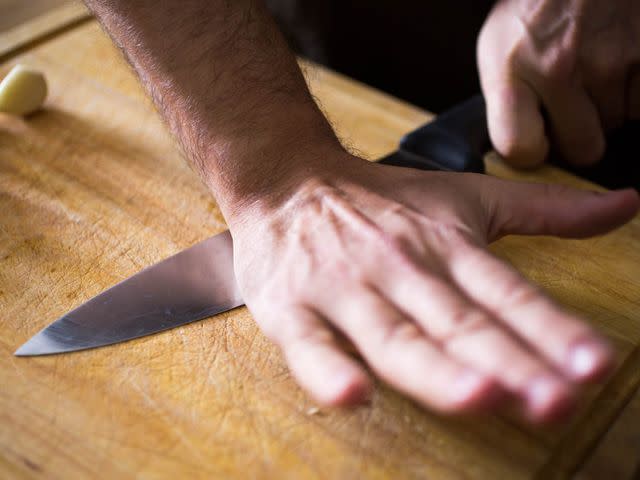
Serious Eats / Daniel Gritzer
January 2015
Read the original article on Serious Eats.

